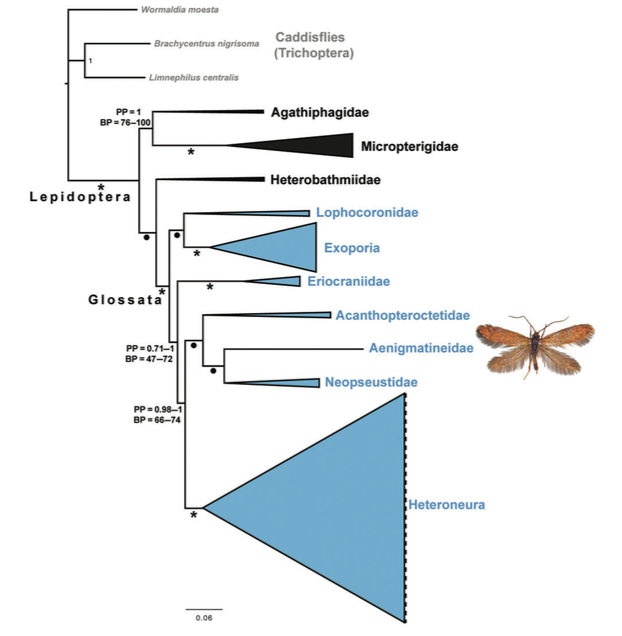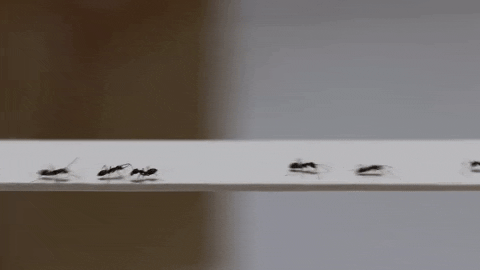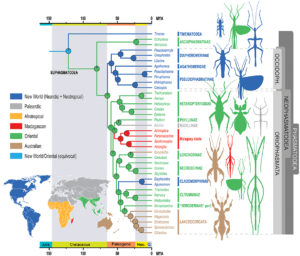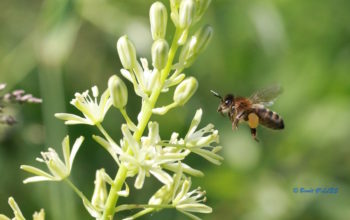The discovery of a new lepidopteran family, unpublished since the 1970s, was made with the capture of a small butterfly on “Kangaroo Island” (Australia). An Australian team, led by N.P. Kristensen, has just described the family Aenigmatineidae. Morphological and genetic studies on these specimens make it possible to reconsider a large part of the evolutionary history and classification of lepidoptera. The evolution of these insects seems more complex than scientists previously thought.
The current butterflies (Lepidoptera) belong almost exclusively (99%) to the phylum (group) of Veteronors : nervation of different and associated forewing and hindwings during flight. In contrast, Homoneures have front and hindwings with identical veins: a primitive character considered as ancestral.
Butterflies are grouped into two categories:
- Les Glossata dont les pièces buccales sont modifiées en “trompe” (proboscis) ayant la faculté de s’enrouler sur elle-même chez les imagos (lire this article), which integrate all heteronors, the family Neopseustidae and the group Exoporia ;
- Les Aglossata qui gardent des mandibules et des mâchoires fonctionnelles non spécialisées à l’état adulte : un trait anatomique ancestral, qui se retrouve chez les Agathiphagidae, les Micropterigidae et les Heterobathmiidae.
caption id=”attachment_1855″ align=”alignright” width=”294″] Photo 1 : Species Aenigmatinea glatzella : (a) male, (b) female on host plant, (c) caterpillar on host plant (Source : Kristensen et al. (2015) – Opus cited, p.8)[/caption]
Photo 1 : Species Aenigmatinea glatzella : (a) male, (b) female on host plant, (c) caterpillar on host plant (Source : Kristensen et al. (2015) – Opus cited, p.8)[/caption]
The interest of this new species, Aenigmatinea <glatzella ( see photo opposite), is that it presents at the same time ancestral anatomical characters like homonor wings, and “modern” (which are found in the current butterflies). Scientists have undertaken morphological and genetic analyses to determine the place of his family within the phylogenetic tree and the classification of lepidoptera.
These results show that Aegnimatinea glatzella is phylogenetically close to Veterans and families Acanthopteroctetidae and Neopseustidae ( see figure 1 at the bottom of page).
binding zone between the proto-cerebral and deuterocerebral, front part of the insect’s brain), a cuticle of the lenses of the ocelli (single eye) thickened and the structure of the first thoracic spiral.
In addition, the caterpillars of A. glatzella have the particularity of developing on conifer species of the genus Callitris (Cupressaceae), as do species of the family Agathiphagidae. Although this characteristic seems ancestral, the feeding strategy of the families Acanthopteroctetidae and Neopseustidae being different, it is possible to think that food independence to conifers occurred secondarily in this species during evolution.
The fact that this small butterfly is related to the taxa of the Veterinarians and Glossata modifies the whole evolutionary history of the Lepidoptera. Entomologists suggested that “modern” butterflies were the result of successive acquisition of morphological characters (heteronuous wings, rollable proboscis…).
This discovery suggests that the evolution of butterflies results from a very complex evolutionary history. It appears that the appearance of the tube occurred several times independently during evolution in different families, and that it had several anatomical homoplasia events : similarity of morphological trait not from a common ancestor but from an evolutionary convergence.
caption id=”attachment_1852″ align=”aligncenter” width=”527″] Illustration 1 : New phylogenetic tree of Lepidoptera (Source : Kristensen N.P et al (2015) – Opus cited, p.13)[/caption]
Illustration 1 : New phylogenetic tree of Lepidoptera (Source : Kristensen N.P et al (2015) – Opus cited, p.13)[/caption]
Source :
– Kristensen N.P. et al (2015) : A new extant family of primitive moth from Kangaroo Island, Australia, and its significance for understanding early Lepidoptera evolution – Systematic Entomology, 40 : 5-16 (lien)





